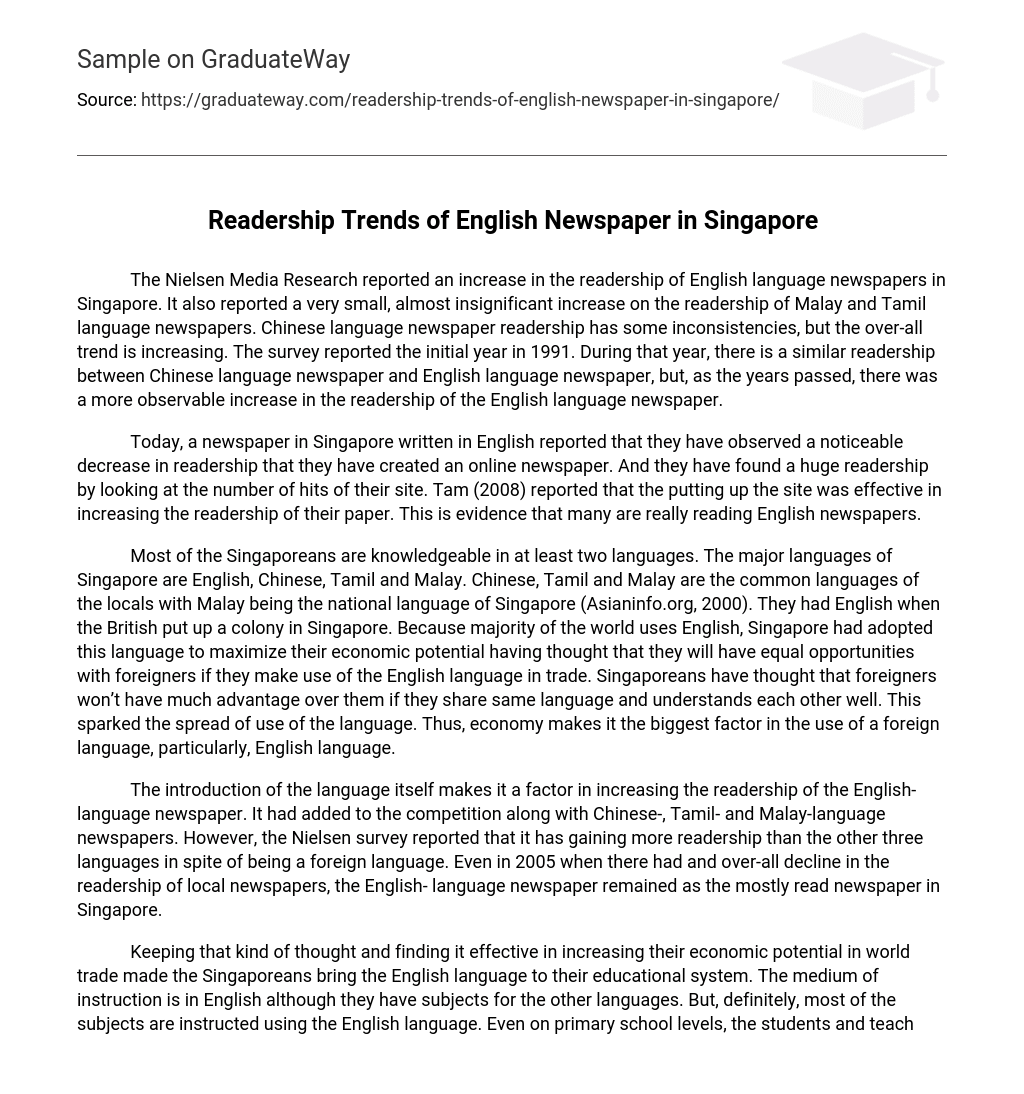The Nielsen Media Research reported an increase in the readership of English language newspapers in Singapore. It also reported a very small, almost insignificant increase on the readership of Malay and Tamil language newspapers. Chinese language newspaper readership has some inconsistencies, but the over-all trend is increasing. The survey reported the initial year in 1991. During that year, there is a similar readership between Chinese language newspaper and English language newspaper, but, as the years passed, there was a more observable increase in the readership of the English language newspaper.
Today, a newspaper in Singapore written in English reported that they have observed a noticeable decrease in readership that they have created an online newspaper. And they have found a huge readership by looking at the number of hits of their site. Tam (2008) reported that the putting up the site was effective in increasing the readership of their paper. This is evidence that many are really reading English newspapers.
Most of the Singaporeans are knowledgeable in at least two languages. The major languages of Singapore are English, Chinese, Tamil and Malay. Chinese, Tamil and Malay are the common languages of the locals with Malay being the national language of Singapore (Asianinfo.org, 2000). They had English when the British put up a colony in Singapore. Because majority of the world uses English, Singapore had adopted this language to maximize their economic potential having thought that they will have equal opportunities with foreigners if they make use of the English language in trade. Singaporeans have thought that foreigners won’t have much advantage over them if they share same language and understands each other well. This sparked the spread of use of the language. Thus, economy makes it the biggest factor in the use of a foreign language, particularly, English language.
The introduction of the language itself makes it a factor in increasing the readership of the English-language newspaper. It had added to the competition along with Chinese-, Tamil- and Malay-language newspapers. However, the Nielsen survey reported that it has gaining more readership than the other three languages in spite of being a foreign language. Even in 2005 when there had and over-all decline in the readership of local newspapers, the English- language newspaper remained as the mostly read newspaper in Singapore.
Keeping that kind of thought and finding it effective in increasing their economic potential in world trade made the Singaporeans bring the English language to their educational system. The medium of instruction is in English although they have subjects for the other languages. But, definitely, most of the subjects are instructed using the English language. Even on primary school levels, the students and teachers had to use the language during instruction due to difficulty in translating scientific and mathematical terms to local languages. Now, it becomes a necessity for students to become literate in the English language aside from comprehending it.
Introducing English language to young people will consequently increase the number of people who speak it and use it. When the students get older, they’ve become adept with the language and both literacy and comprehension with the foreign language comes at ease.
Because of this big influence of the English language on the educational system of Singapore, the English language was able to overpower other naturally local languages. It is probable that the this overwhelming influence of English over the economic and educational systems of Singapore had made some Singaporeans learn English more than the other languages or not to learn the other languages aside from English and the language they use at home. For example, Indians have learned Tamil and English languages but have not learned Chinese and Malay. This can affect newspaper readership in a way that the newspapers in local languages are more probably being read only by those group of people who are very much familiar in that specific local language. It couldn’t match the readership that the English-language newspaper gets because of few audience or readers unlike English-language texts which can be comprehend by the majority. This could explain the almost insignificant in the change in the readership of Tamil- and Malay- language newspapers.
Another factor that can attribute to the increased readership of the English language would be the social influence of the language to the locals of Singapore. Because many are becoming English-educated, many, now, reads newspapers in the English language. It continues to increase because the use of English in the educational system of Singapore also continues and is growing. This means that there will be an expected further increase in the readership of the English- language newspaper.
This increase in the readership of the English-language newspaper will affect the readership of the other language written newspapers because it will lessen the number of people who buys and reads newspaper in other languages. It could lead to a lessened circulation of the other language written newspapers which would only lessen readership because of few circulating newspapers. Then, with lesser options, the English-language newspapers would gain more readership.
The current trend in technology also affects newspaper readership in a way that internet makes it easier to gain access to a lot of information than newspapers, thus, affecting readership of newspapers. However, newspapers can remain intact to its goal of spreading news and information when they embrace the technology of internet (Peng, Tham, Xiaoming, 1999).
References:
Tam, Ariel. 28 March 2008. EasyReader – boon for TODAY readers. Retrieved 23 July 2009 from http://www.channelnewsasia.com/stories/technologynews /view/337786/1/.html.
SPH Newspapers Readership Trends. 2007. Singapore Press Holdings Annual Report 2007. Retrieved 24 July 2009 from http://www.sph.com.sg/pdf/annualreport/ 2007/readership_trends.pdf
Asianinfo.org. 2000. Singapore Language and Literacy. Retrieved 24 July 2009 from http://www.asianinfo.org/asianinfo/singapore/pro-languages.htm.
Peng, F.Y., N.I. Tham and H. Xiaoming. 1999. Trends in Online Newspapers: A Look at the US Web. Retrieved 24 July 2009 from http://www.questia.com /googleScholar.qst;jsessionid=KyqB43G7G2T80465FG86MDcv6b1yQJhHCLY0Y96CDtXGzy9Qp24!1204335666!920949310?docId=5002320220.
Kuo, E. and E. Afendras. N.d. Language and Society in Singapore. Singapore University Press: Singapore.
Advertising and Circulation Trends. N.d. Singapore Press-Pedia. Retrieved 24 July 2009 from http://presspedia.journalism.sg/doku.php?id=Home.





